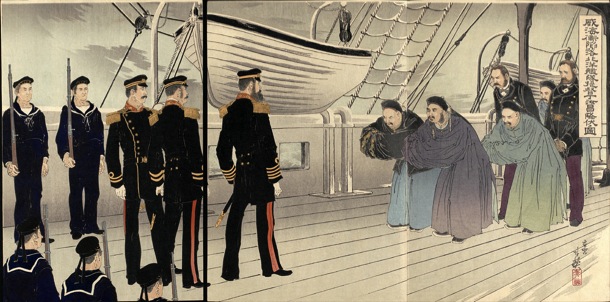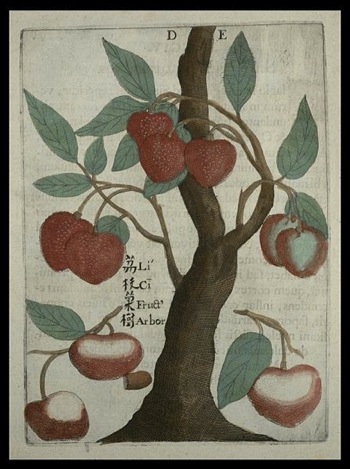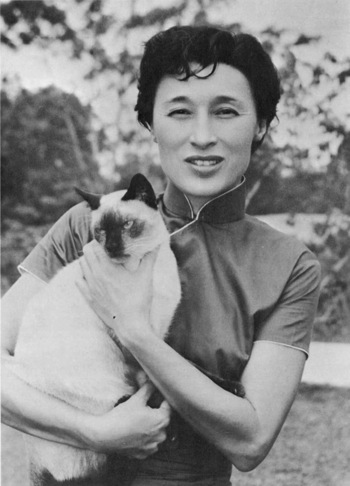|
||||||||||
|
NEW SCHOLARSHIPRepresenting China: From the Jesuits to Zhang YimouThe University of Manchester, 18-20 May 2011A conference report by Daniel SandersonThe three-day conference, Representing China: From the Jesuits to Zhang Yimou, was convened to discuss the various ways that China has been presented to foreign publics since the sixteenth century and the political and cultural implications of such representations. Bringing together an eclectic range of scholars from universities in Australia, Hong Kong, Taiwan, Europe, the United States and the UK, the conference provided an intense and stimulating forum for the discussion of this seemingly unwieldy subject. The conference was organised and supported by The University of Manchester's Centre for Chinese Studies and its Confucius Institute, as well as the University's Jean Monnet Centre for Excellence. Before the formal program began, the participants were treated to a viewing of an edition of the late-eighteenth century volume of prints, Twenty Views of the Qianlong Emperor's European Palaces in the Garden of Perfect Brightness, held at the University's John Rylands Library. Commissioned by the Emperor during the 1760s and printed in France, the Rylands album was recently uncovered by Dr Yangwen Zheng. It is one of only four extant copies of the Views known to exist. It is unique in that one of its images has been hand coloured, perhaps giving some indication of the appearance and decoration of the palaces at the time. The official conference proceedings were opened with a public keynote lecture given by Benjamin Elman, Head of East Asian Studies at Princeton University. Chaired by Hugh Davies, Chairman of The China Association and former senior British diplomat in China and Hong Kong, the lecture was presented in the Library's main hall. The title of Professor Elman's talk—'Rethinking the Image of China in Global History'—set the tone for the ensuing two days of discussion. Elman's emphasis on the important influence of Japanese artists, journalists and scholars on Western perceptions of China's nation weakness, particularly in the late- nineteenth and early twentieth centuries, provided an early reminder that the sources of Western 'knowledge' of China were often to be found far from China itself, in both geographical and intellectual terms.  Fig.1 'After the Fall of Weihaiwei, the Commander of the Chinese Beiyang Fleet, Admiral Ding Juchang, Surrenders', woodblock print by Mizuno Toshikata, November 1895
The panel sessions began the following morning with three papers grouped under the title, 'Jesuits and the China they invented'. Marie-Julie Maitre (Chinese University of Hong Kong) examined the Jesuits' role in shaping French perceptions of Chinese philosophy—both positive and negative—during the seventeenth and eighteenth centuries. In a paper entitled 'Representing China musically or representing musical China?', the musicologist Anna G. Piotrowska (Jagiellonian University) charted the development of Western understandings of the Chinese musical tradition, beginning with the first Jesuit accounts, before discussing attempts by various composers to incorporate Chinese elements into their works. Piotrowska concluded that in almost all cases a diffuse exoticism substituted for any meaningful engagement with actual Chinese musical practices. Yangwen Zheng, the convenor of the conference, concluded the panel with a paper that charted the course of change in Western perceptions of China from the mid-eighteenth century up to the First Opium War. Zheng asked broad questions about the reasons for Western fascination with China during the eighteenth century and for the subsequent decline in China's intellectual prestige in the West.  Fig.2 A photograph taken by American anthropologist Joseph Rock in Dali, Yunnan, during the 1920s The second panel focused on American perceptions of China. Dael Norwood (Princeton University) revealed the surprisingly important role played by the lure of China, with its wealth and huge potential market, in shaping plans for commercial and geographical expansion among American politicians and businessmen in the decades after the War of Independence. Henna-Riikka Pennanen (University of Jyväskylä) explained her use of critical discourse analysis in her study of the American missionary W.A.P. Martin's writings, focusing particularly on Martin's understanding of the notion of 'civilization'. For Martin, civilization was characterised by growth and dynamism, two qualities which he saw as entirely lacking from the China he observed around him. Indeed, according to Pennanen, Martin's 'China' became in part a work of imagination created to suit his own arguments about civilization and the need for progress. In the next paper, Peng-hui Wang (National Taiwan University) examined the photography and anthropological work of another American, Joseph Rock, and the British-Australian C.P. Fitzgerald, who both spent significant periods in Southwest China. Largely forgotten for many decades, these 'foreign' representations are now being used in China itself to reconstruct a nostalgic vision of a once-wild frontier. The third panel, entitled 'Ethnic and Unofficial China', remained in frontier territory but took a different perspective, examining representations originating from within China and emphasising the representation of local difference over more homogenised notions of 'Chineseness'. Chris Vasantkumar (Hamilton University) examined the effect of changing patterns in tourism on the development of new representations of ethnic difference in the Tibetan areas of Gansu province. David Tobin (University of Manchester) presented findings from recent fieldwork conducted in Xinjiang which belied official representations of China's frontier as ethnically harmonious and uncomplicatedly patriotic. Tobin found that, for many of his interviewees, allegiance to ethno-linguistic or religious groups was more powerful than any sense of national belonging. Karita Chan (University of Oxford) explored the issue of cultural representation in the public squares of cities in the Pearl River Delta region. According to Chan, this rapidly expanding guangchang wenhua is the site of a continued struggle between official, commercial and popular ideas of leisure and cultural production.  Fig.3 A page from Flora Sinensis, published in 1656 in Vienna by the Polish Jesuit missionary, Michael Boym James St André (University of Manchester) opened the last panel of the day with a paper on the representation of the Chinese language in Western texts and images over the period 1630-1900. Bringing together a fascinating array of sources, St André traced an intellectual journey from mystification through approbation to contempt which mirrored the changes in the broader Sino-foreign relationship. Monika Lehner (University of Vienna) explored the development of visual representations of China and Chinese objects in travelogues and proto-encyclopaedic books in the years before 1800. Louise Tythacott (University of Manchester) concluded the day's proceedings with a paper on the extraordinary story of how China was represented at the Great Exhibition of 1851. Without support from the Chinese Imperial authorities, the Exhibition's organisers turned to an antique dealer to accumulate sufficient objects of Chinese provenance to furnish a modest display. The lacklustre result, Tythacott argues, served to reinforce a growing consensus in Europe on China's backwardness. The panels on Day Three began with three papers linked by a common interest in Western representations of high Maoism. Daniel Sanderson (The Australian National University) spoke on the Chinese-Belgian romance novelist and prominent supporter of 'Red China' Han Suyin, locating her extraordinary success as a communicator on Chinese revolutionary matters in her ability to meet Western cultural expectations of an exotic and glamorous East. In the next paper, Kaz Ross (University of Tasmania) asked whether the attempt to present a picture of a 'true' China is doomed to failure. Using the example of Julia Kristeva's writing on China, Ross called for a 'postcolonial sinology' that recognised the necessary incompleteness of all representations of China. The following paper, by Catherine Dossin (Purdue University), took up Ross' thread by examining the 1974 China tour of prominent French intellectuals of which Kristeva had been a member. Dossin argued that, despite a wide variety of responses recorded in their published and private accounts, these intellectuals found little more in China than the selves they took with them.  Fig.4 Han Suyin. (Photograph: Kathinka Fox) Carl Kilcourse (University of Manchester) opened Panel Six with a paper on missionary accounts of the Taiping Rebellion. Rather than using these records as sources for military or political history, Kilcourse focused instead on Western Protestant missionaries' understanding of Taiping theology, noting particularly the widely held view of this localised version of Christianity as 'distorted' or 'blasphemous'. David Woodbridge (University of Manchester) examined Western representations of the Chinese Christian church leader Watchman Nee, who became a popular figure among Christian circles in the West, particular after his imprisonment by the Communist authorities in 1952. The panel's final paper, by Kelvin Cheung (University of Manchester), suggested possible ways of applying theoretical paradigms to the study of the Chinese leadership's perception of security threats using concepts from traditional Chinese medicine. The seventh and last panel of the conference was also one of its liveliest. Felicia Chan (University of Manchester) gave a chronological analysis of what she calls the 'shifting visual politics' of the films and other productions of Zhang Yimou. Heather Schmidt (University of Alberta) explored the borders between culture and politics in her paper on the Edmonton Confucius Institute and its relationship with the local Public School Board. Focusing on an advertising campaign for the Institute's Chinese language program for children, she questioned the idea of a unidirectional transfer of Chinese language and culture from China to its foreign recipients, highlighting rather the involvement of local people, schools and other institutions in shaping a particular vision of the desirability of China and Chinese culture through the Institute's programs and activities. The final paper of the conference was presented by Astrid Nordin (University of Manchester), whose interpretation of the 2010 Shanghai World Expo as a Baudrillardian simulacrum questioned the validity, and indeed the very possibility, of representation itself. Upon conclusion of the formal panels, a roundtable discussion on the role of scholars in fostering a better representation of China ensued. Yangwen Zheng drew out a number of broad questions that had emerged from the three days' presentations: What is the China that is being represented, and by whom? How has China presented itself? And, of particular cogency in the context, what constitutes a China expert? That Western perceptions of China have been based consistently on imperfect representations was acknowledged. However, some questioned the role of academics in changing these perceptions. Taking up Astrid Nordin's cue, some participants suggested that the idea of 'representation' was itself part of the problem, putting forward alternatives such as 'brokerage' or 'refraction' which acknowledged the partial and divergent ways in which any entity of such complexity as China can be described. In a short session it was impossible to discuss at length all the issues at play, but it was hoped that the conversation started in Manchester might continue. A volume of essays based on papers given at the conference is currently under preparation. Related material from China Heritage Quarterly:
|